Caustic Soda Market Overview:
The global caustic soda market is witnessing consistent growth, fuelled by demand from industries such as chemicals, pulp and paper, textiles, and water treatment. Caustic soda, also known as sodium hydroxide, is a key chemical used in a variety of industrial processes. This report offers an in-depth analysis of procurement trends, with a focus on cost optimization strategies and the role of digital tools in enhancing procurement and manufacturing operations.
Companies are increasingly relying on market intelligence to drive procurement decisions, improve efficiency, and mitigate potential risks. As global demand for caustic soda continues to grow, companies are utilizing strategic sourcing and digital procurement solutions to stay competitive and minimize supply disruptions.
The caustic soda market is anticipated to continue growing steadily through 2032, with the following key highlights:
- Market Size: The global caustic soda market is projected to reach USD 59.3 billion by 2032, expanding at a CAGR of 3.7% from 2024 to 2032.
Growth Rate: 3.7% 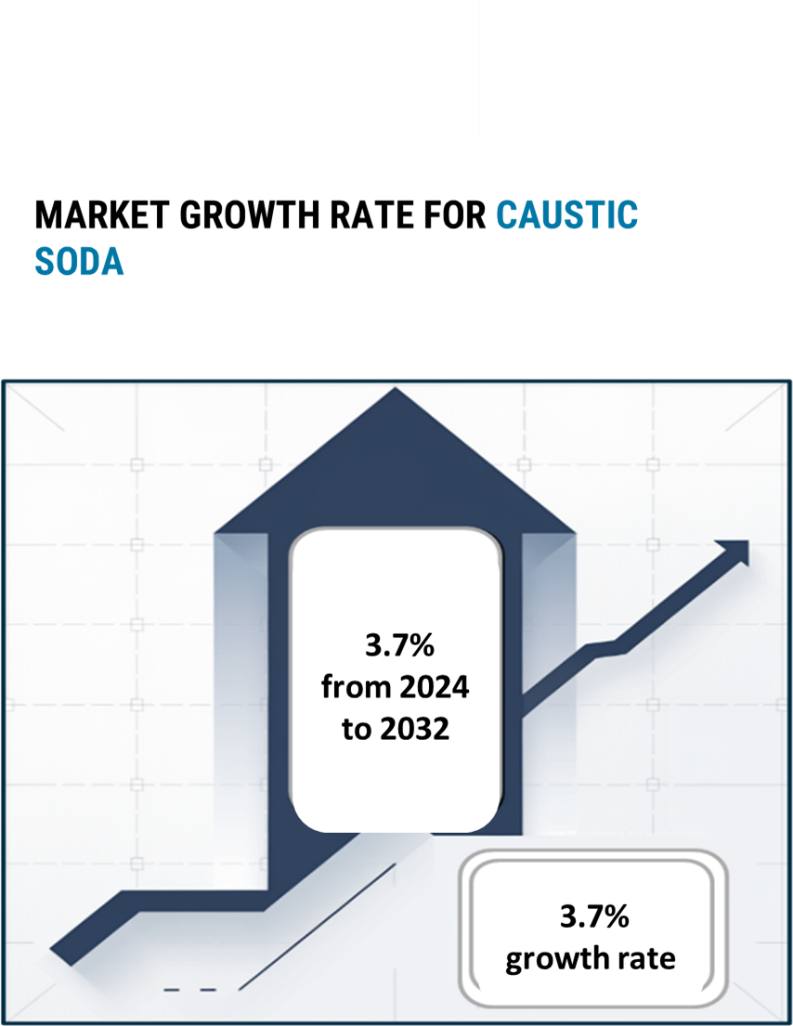
- Sector Contributions: The market's growth is being driven by:
- Chemical Industry Demand: Growing production of chemicals, including petrochemicals, and demand for caustic soda in various chemical processes.
- Water Treatment Needs: Increasing demand for caustic soda in water purification and waste treatment applications.
- Technological Advancements: Innovations in caustic soda production technologies, such as membrane cell technology, are improving operational efficiency, reducing energy consumption, and enhancing environmental sustainability.
- Investment Trends: Companies are investing in modernized production facilities and digital solutions, such as real-time monitoring and automation, to increase manufacturing efficiency and optimize costs.
- Regional Insights: Asia-Pacific remains the largest contributor to the caustic soda market due to high industrial output and the growing chemical manufacturing sector. North America and Europe also remain significant markets for caustic soda, driven by strict regulatory requirements and sustainable production practices.
Key Trends and Sustainability Outlook:
- Digitalization in Production: The use of automation and data analytics in caustic soda production is improving operational efficiency, reducing errors, and optimizing resource management.
- Advanced Production Methods: The development of advanced membrane and diaphragm cell technologies is increasing the energy efficiency and environmental sustainability of caustic soda production.
- Focus on Sustainability: Growing environmental concerns are pushing companies to focus on reducing the environmental impact of caustic soda production, promoting eco-friendly alternatives, and improving energy usage efficiency.
- Customization Trends: There is a rising demand for specialty caustic soda products tailored to specific industries such as textiles, food processing, and pharmaceuticals.
- Big Data in Manufacturing: Leveraging big data and predictive analytics is helping manufacturers optimize production schedules, reduce waste, and maintain consistent quality in caustic soda products.
Growth Drivers:
- Chemical Manufacturing Growth: The increasing demand for chemicals, including petrochemicals, is a significant driver for the need for caustic soda in industrial processes.
- Environmental Regulation Compliance: Stringent environmental and safety standards are pushing companies to adopt more efficient and environmentally friendly caustic soda production processes.
- Water Treatment and Waste Management: The growing need for efficient water treatment solutions is increasing the demand for caustic soda in the treatment and purification of water.
- Sustainability Focus: Companies are prioritizing sustainable manufacturing processes and investing in technologies that minimize environmental impact and improve resource efficiency.
- Industry-Specific Customization: Industries such as textiles, pulp and paper, and food processing are increasingly seeking customized caustic soda solutions that cater to their specific production requirements.
Overview of Market Intelligence Services for the Caustic Soda Market:
Recent analyses of the caustic soda market highlight key challenges such as fluctuating raw material costs, regulatory pressures, and complex supply chains. Market intelligence services provide actionable insights that help companies navigate these challenges, identifying cost-saving opportunities, improving vendor management, and strengthening supply chain resilience. These insights also support compliance with safety and environmental standards while optimizing procurement and manufacturing operations.
Procurement Intelligence for Caustic Soda: Category Management and Strategic Sourcing:
To stay competitive in the caustic soda market, companies are optimizing procurement strategies by implementing spend analysis and utilizing market intelligence to track vendor performance. Effective category management and strategic sourcing are essential for reducing procurement costs and securing reliable supplies of high-quality caustic soda. By leveraging actionable insights from market intelligence, companies can streamline procurement processes, negotiate favourable terms, and enhance overall supply chain efficiency.
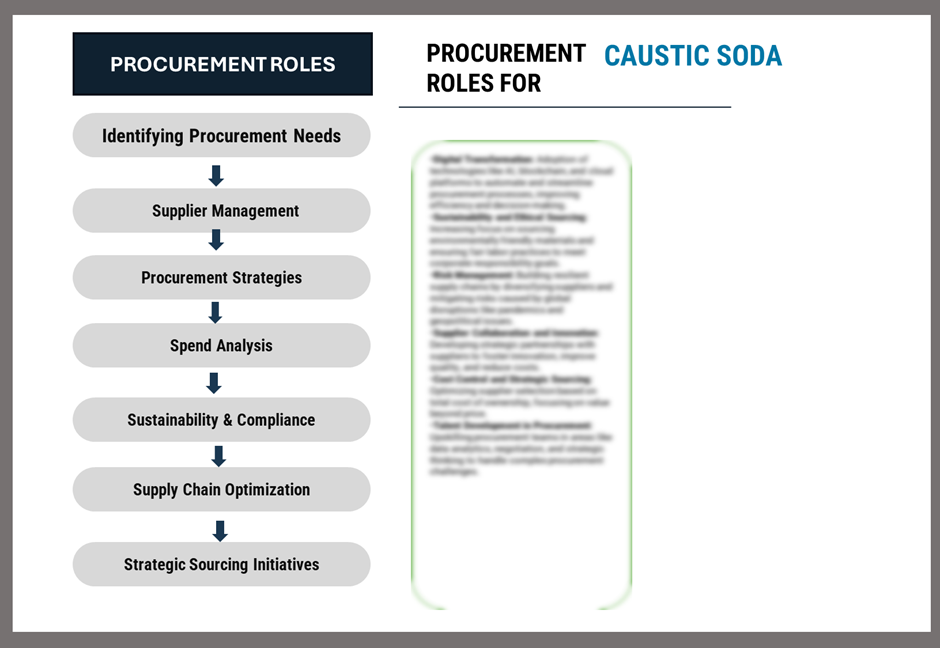
Pricing Outlook for Caustic Soda: Spend Analysis
The pricing outlook for caustic soda is anticipated to remain relatively stable, with some price volatility due to several key factors. Fluctuations in raw material costs, particularly for soda ash and other essential chemicals, are major contributors to changes in pricing. Additionally, the increasing demand for caustic soda in industries such as chemicals, water treatment, and textiles is influencing pricing trends.
Graph shows general upward trend pricing for caustic soda and growing demand. However, there may be fluctuations influenced by economic conditions, technological advancements, and competitive dynamic.

Efforts to optimize production processes, reduce waste, and implement advanced technologies such as membrane cell technology are essential for managing costs. The development of alternative materials and more efficient production methods can help mitigate price increases.
Collaborating with sustainable suppliers, focusing on eco-friendly manufacturing practices, and improving logistical efficiency are critical strategies for controlling costs. Despite these challenges, maintaining a focus on research and development, quality assurance, and regulatory compliance will be essential to effectively manage pricing.
Cost Breakdown for Caustic Soda Total Cost of Ownership (TCO) and Cost-Saving Opportunities:
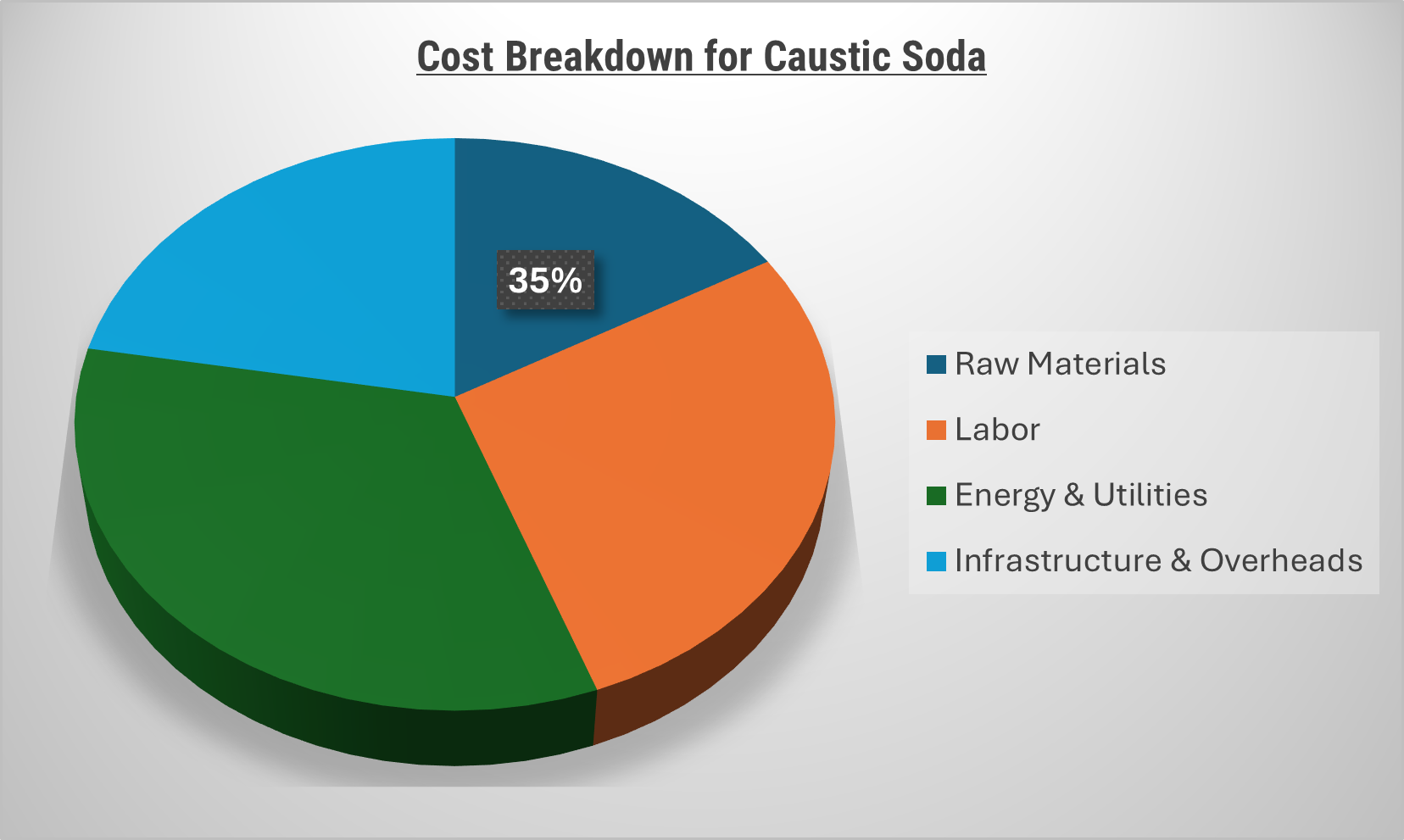
- Raw Materials (35%)
- Description: Raw materials used in caustic soda production, including soda ash and chlorine, must meet industry standards for quality, safety, and durability. The cost of these materials is heavily influenced by global supply-demand dynamics and environmental regulations.
- Trends: Rising demand for caustic soda across industries, as well as increased focus on sustainability, is prompting the search for eco-friendly and efficient materials. Suppliers are employing innovative techniques to improve material usage and reduce environmental impact.
- Labor (XX%)
- Energy & Utilities (XX%)
- Infrastructure & Overheads (XX%)
Cost-Saving Opportunities: Negotiation Levers and Purchasing Strategies
In the caustic soda industry, refining procurement approaches and enhancing production efficiencies can result in significant cost savings. Establishing long-term relationships with key raw material suppliers, particularly for soda ash and chlorine, can provide opportunities for bulk discounts, helping to reduce overall unit costs. Strategic collaborations with manufacturers can lead to cost reductions through improved payment terms, economies of scale, and shared production resources.
Investing in advanced production technologies, such as membrane cell technology and energy-efficient systems, can lower labor and energy costs while enhancing production accuracy and reducing waste. Focusing on sustainable production practices and sourcing eco-friendly raw materials can not only help cut operational costs but also appeal to sustainability-conscious consumers. Companies can also consider multi-sourcing strategies to reduce risks associated with supply chain disruptions and improve negotiating leverage with suppliers.
Supply and Demand Overview for Caustic Soda: Demand-Supply Dynamics and Buyer Intelligence for Effective Supplier Relationship Management (SRM)
The caustic soda market is experiencing growth due to increased demand in various sectors such as chemicals, water treatment, and textiles. The supply and demand dynamics are influenced by continuous advancements in manufacturing processes, evolving customer needs, and global market expansion.
Demand Factors:
- Chemical Manufacturing Growth: The demand for caustic soda is driven by its essential role in producing various chemicals, including petrochemicals and plastics.
- Water Treatment Needs: Growing requirements for water purification and waste treatment drive the demand for caustic soda in municipal and industrial water treatment processes.
- Textile Industry Expansion: The use of caustic soda in fabric processing, dyeing, and cleaning further contributes to demand in the textile sector.
- Environmental Regulation Compliance: The increasing need for industries to meet stringent environmental regulations also fuels demand for caustic soda in effluent treatment and cleaner production processes.
Supply Factors:
- Technological Advancements: Continuous improvements in caustic soda production technologies, such as more efficient membrane cell processes, enhance supply capabilities and reduce energy consumption.
- Availability of Skilled Labor: The availability of skilled workers proficient in chemical production and quality control impacts the efficiency and quality of caustic soda production.
- Global Production Networks: The growth of manufacturing facilities in regions with lower labor costs, such as Asia-Pacific, helps optimize supply chains and reduce production costs.
- Supplier Competition: Increased competition between suppliers promotes better pricing, higher quality products, and improved cost efficiency, benefiting buyers and driving competitive pricing in the market.
Regional Demand-Supply Outlook: Caustic Soda
The Image shows growing demand for caustic soda in both Asia Pacific and North America, with potential price increases and increased Competition.
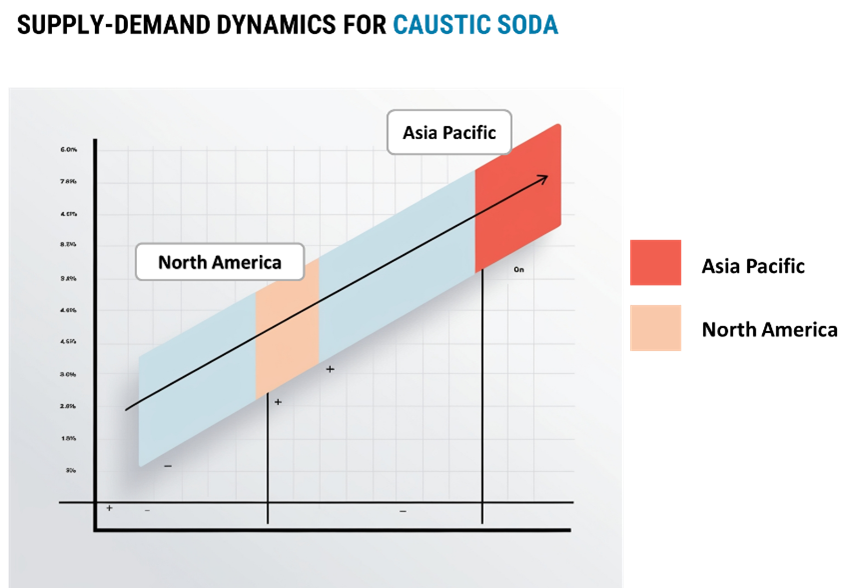
Asia Pacific: Dominance in Caustic Soda
Asia Pacific, particularly countries like China, India, Japan, and South Korea, plays a critical role in the global caustic soda market, driven by several key factors:
- Rapid Industrial Growth and Chemical Manufacturing: The Asia Pacific region, with its booming chemical and petrochemical industries, is a major consumer of caustic soda.
- Strong Production Capabilities: Asia Pacific boasts a high concentration of caustic soda production facilities, particularly in China and India, equipped with advanced production technologies
- Growing Demand in Water Treatment and Environmental Regulations: As water treatment and effluent management regulations become stricter across the region, countries like India and China are increasing their use of caustic soda in industrial wastewater treatment processes, driving additional demand for the chemical.
- Technological Advancements and Sustainable Practices: Leading countries in the region, such as Japan and South Korea, are adopting innovative production technologies to improve the efficiency of caustic soda production.
- Infrastructure and Urbanization: The rapid urbanization in countries like China and India, along with significant infrastructure development in Southeast Asia, has led to increased demand for caustic soda in construction, water treatment, and other industrial processes
Asia Pacific Remains a key hub caustic soda price drivers Innovation and Growth.

Supplier Landscape: Supplier Negotiations and Strategies
The supplier landscape in the caustic soda market across is diverse, with a mix of both global giants and regional manufacturers playing a significant role in the market’s development. These suppliers have a considerable influence on critical aspects such as pricing, innovation, and the availability of high-quality caustic soda. The market is highly competitive, with established players dominating global market share while smaller, regional firms focus on niche applications and emerging industries like water treatment, textiles, and chemicals.
Currently, the supplier landscape is seeing considerable innovation and strategic partnerships, as major players continue to lead in market share, while smaller companies focus on expanding their influence in specific markets such as water treatment, chemical manufacturing, and industrial applications.
Key suppliers in the caustic soda market in include:
- Nippon Soda Co., Ltd.
- Soda Sanayi A.Ş.
- Shandong Hualu-Hengsheng Chemical Co., Ltd.
- Tianjin Zhong Tai Chemical Co., Ltd.
- China National Chemical Corporation (ChemChina)
- Reliance Industries Limited
- SABIC (Saudi Basic Industries Corporation)
- LG Chem Ltd.
- Indo-Gulf Fertilizers & Chemicals Ltd.
- Lotte Chemical Corporation
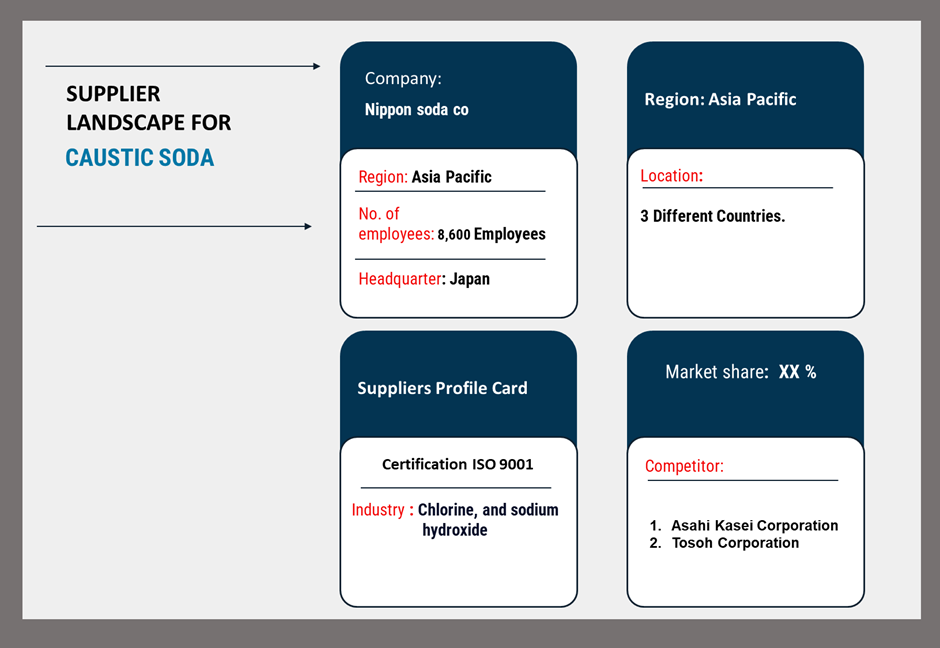
Key Developments Procurement Category Significant Development:
|
Significant Development |
Description |
|
Market Growth |
The global caustic soda market is expanding, driven by rising demand from sectors such as chemicals, water treatment, and textiles. |
|
Sustainable Practices |
Emphasis on environmentally friendly production methods and energy-efficient technologies supports sustainability and regulatory compliance. |
|
Product Diversification |
Diversification in caustic soda applications, including use in chemical manufacturing, paper production, and wastewater treatment, meets varied needs. |
|
Technological Innovations |
Adoption of advanced technologies such as membrane cell processes and energy recovery systems enhances efficiency and reduces production costs. |
|
E-commerce Expansion |
Growth in online platforms improves global accessibility, facilitating the distribution of caustic soda to industrial buyers across various regions. |
|
Focus on Quality Standards |
Increasing demand for high-purity caustic soda to meet stringent safety and performance requirements in critical applications. |
|
Regional Manufacturing Hubs |
Development of regional production hubs in Asia Pacific, particularly in China and India, ensures cost-effective production and robust supply chains. |
|
Caustic Soda Attribute/Metric |
Details |
|
Market Sizing |
The global caustic soda market is projected to reach USD 59.3 billion by 2032, expanding at a CAGR of 3.7% from 2024 to 2032. |
|
Technology Adoption Rate |
Around 35% of manufacturers are adopting advanced technologies like membrane cell processes and energy recovery systems. |
|
Top Strategies for 2024 |
Focus on enhancing production efficiency, adopting sustainable practices, meeting regulatory compliance, and expanding supply capacity. |
|
Process Automation |
Approximately 25% of companies have implemented automation in production processes to optimize efficiency and reduce costs. |
|
Process Challenges |
Key challenges include addressing fluctuations in raw material availability, ensuring environmental compliance, and managing production costs. |
|
Key Suppliers |
Leading suppliers include China National Chemical Corporation (ChemChina), Tosoh Corporation, and LG Chem, among others. |
|
Key Regions Covered |
Asia Pacific, North America, and Europe, with significant demand in China, India, the U.S., and Germany due to industrial growth. |
|
Market Drivers and Trends |
Growth driven by rising demand in water treatment, paper and pulp, chemical manufacturing, and increased focus on sustainability. |








